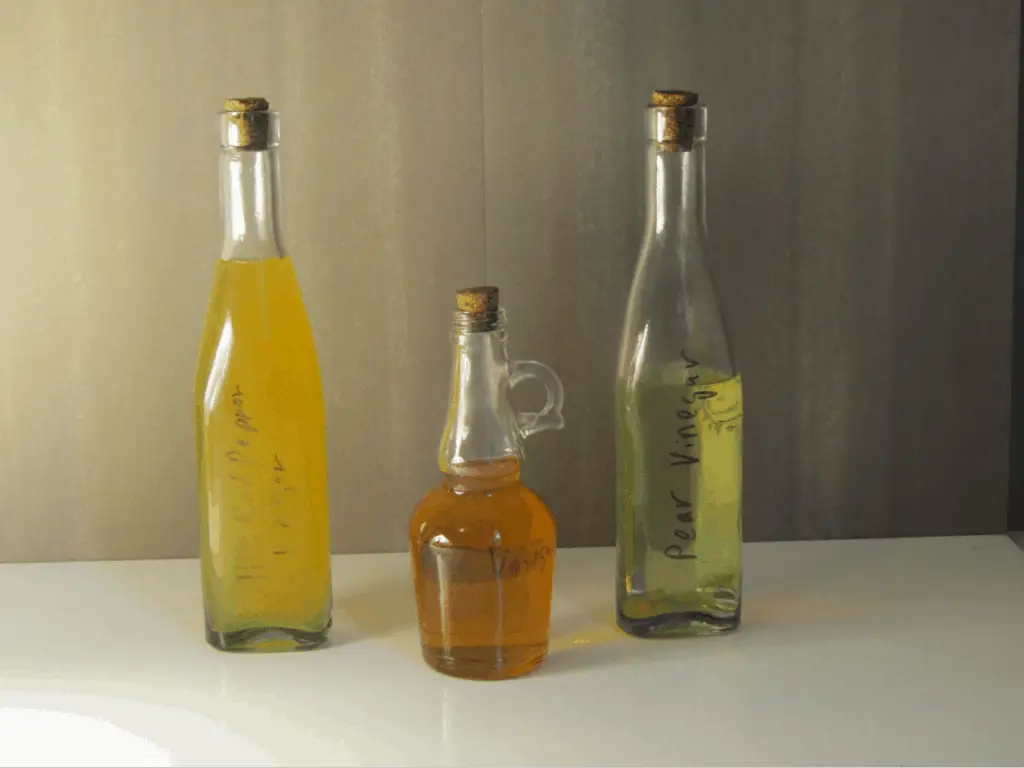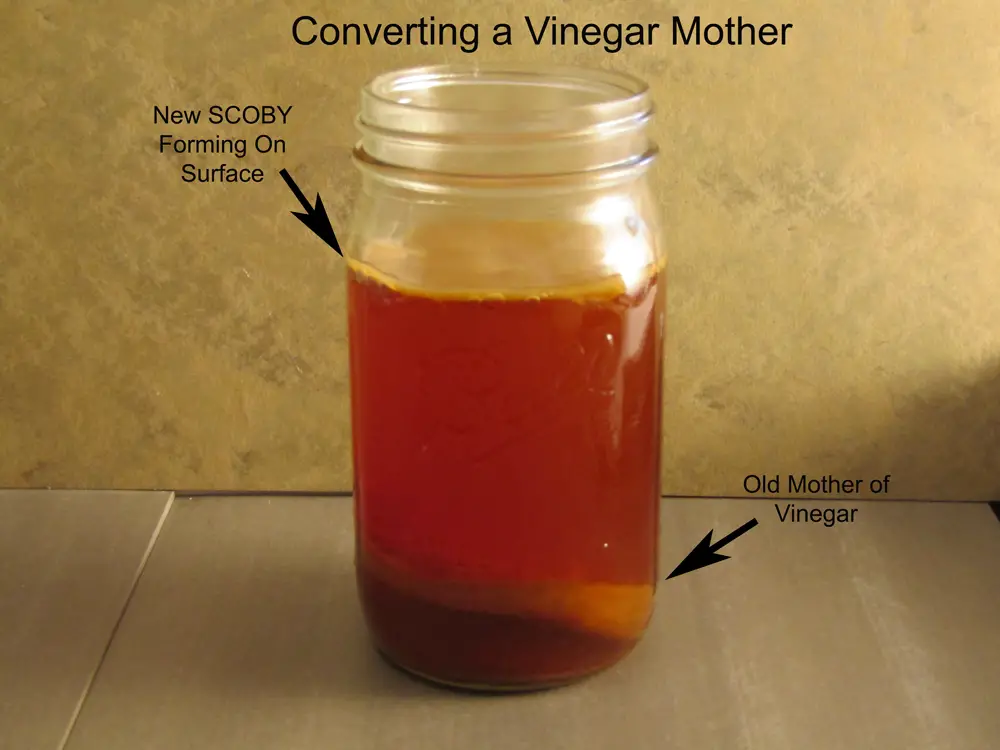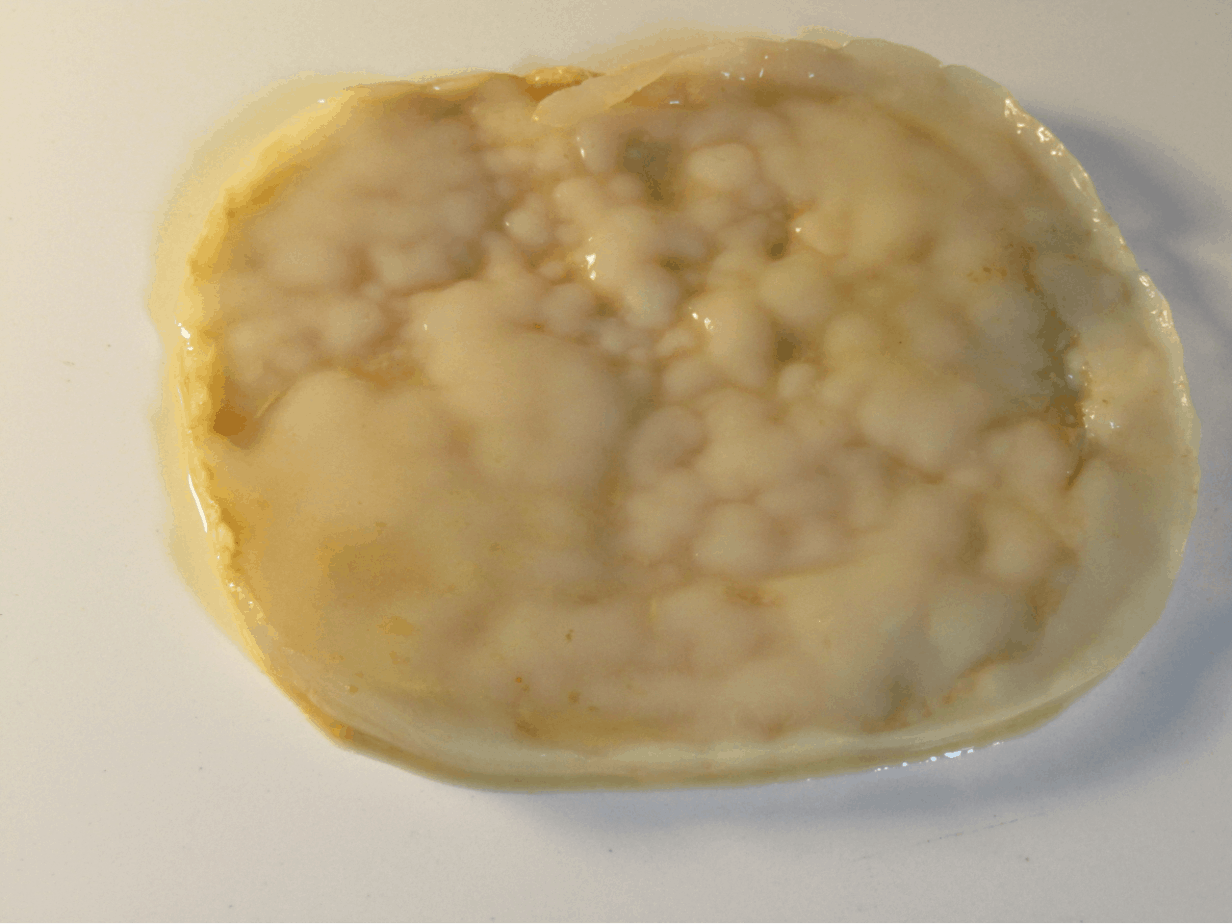This post contains affiliate links.
When you are making vinegar for the first time you have a choice of systems you can use. There are several methods to choose from with different types of equipment (for an explanation of the equipment you will need read What Equipment is Available to make Vinegar).
If you choose the jar method or the wooden barrel method you will be introduced to a growth which appears on the surface of the fermenting liquid. It will first appear as a light colored scum like substance and over time will thicken and form a pliable tough covering over the entire surface of the vinegar container. This is a vinegar mother and serves several purposes in making vinegar.
The problem is that every batch produces another vinegar mother and eventually your jar will be mostly vinegar mother rather than vinegar. Instead of just throwing them away, composting them or storing them forever here are some great ways to use some of these vinegar mothers.
Start a Different Type of Vinegar

This is a typical use of extra vinegar mothers, they provide an inoculation step which shortens the time needed to produce vinegar. The vinegar mother has active acetic acid bacteria in and around it which go to work as soon as they are exposed to the new liquid you want to convert into vinegar.
Steps to use a vinegar mother for a different batch of vinegar
- Prepare the vinegar base
To use an already established vinegar mother you will need to start with a liquid base which has at least some alcohol in it to start. The vinegar mother has active acetic acid bacteria in and around it which need the energy supplied by the alcohol.
You can either:
Use prepared alcohol
Acetic acid bacteria grow well in an environment with an ABV between 5-12%. This makes it easy to make vinegar from beer, wine or cider which can be purchased at the store. Ensure the ABV is between the above range as without enough alcohol content the vinegar will not be acidic enough for long term storage and to high an ABV and it will not be able to grow properly.
Prepare your own
To prepare your own vinegar base you can use a finished alcoholic beverage such as hgher ABV content wine, or spirits and dilute it to the desired concentration or you can start with raw ingredients as you would for make vinegar starting with no alcohol.
- Acidify the liquid
This step will protect the vinegar from mold growth. Molds love warm humid environments high in sugar or complex carbohydrates. This makes the edges of the liquid very susceptible to contamination.
To prevent this you can acidify the liquid before the mold can get a foothold. To do this just add some similar vinegar to the liquid or add some acidic acid powder which can be found at local wine making stores or online.
- Add the vinegar mother to the liquid
The vinegar mother does not need to cover the surface of the liquid, float on the top or grow additional layers to be useful for making vinegar. The purpose of the vinegar mother is to inoculate the liquid with the acetic acid bacteria which naturally produce the biofilm and in turn forms the vinegar mother.
By adding some of a vinegar mother to the liquid the active acetic acid bacteria will immediately start to convert the alcohol into acetic acid and start producing biofilm which will become a new vinegar mother.
Why you want a vinegar mother
The vinegar mother in biology is called a pecille. Pecilles are formations of mostly cellulose which makeup a thick mat and house some forms of bacteria. It protects the surface of the vinegar from contamination and provides oxygen exchange with the air into the liquid for the acetic acid bacteria to use while converting the alcohol into acetic acid.
Concerns about using a vinegar mother to start a different type of vinegar
- Flavor transfer
Although some of the flavors of the original vinegar will be included by the mother very little of it will transfer into the new vinegar so don’t worry about altering the flavor of your new vinegar.
- Contamination from unwanted microorganisms
When you move a vinegar mother from one container from another you are performing a method of inoculation which has been used for centuries called backslopping.
Backslopping will transfer any microorganism from one fermentation to another so this is a valid concern.
To ensure you are not transferring unwanted things into your new vinegar taste the vinegar it came from before you use it. If it has unwanted flavors throw it away. You can always start your new vinegar without a mother.
- Old vinegar mother is not active enough
When a vinegar mother matures its density increases and sometimes it will sink to the bottom of the container. This raises the concern that it is not active enough to be useful for making vinegar.
Using an older vinegar mother is not a problem as the acetic acid bacteria which produced the mother will still be present. Once they are introduced to a new batch they will begin to multiply and produce a new mother which will form at the top of the liquid.
Some recipes to try
Red wine vinegar
A good vinegar for making rich soups, sauces and gravy this vinegar gets better with age either in glass containers or wooden barrels.
Stout beer vinegar
For those who like beer bread or beer barbeque sauce this is a natural. The deep color and flavor of this vinegar goes great with outdoor food or grilled meats
Homemade fruit wine vinegar
This vinegar can have a lighter flavor which is great for light salad dressings, chip dips and shrubs. The tangy flavor adds depth and interest to anything.
Use a vinegar mother to start some Kombucha

It may come as a surprise to some but a SCOBY and a vinegar mother are closely related. In fact they are made by the same family of acetic acid bacteria.
Vinegar is usually a longer process than making Kombucha taking months to years depending on the type and method you are using to make vinegar. As a result the microbial activity is different. Species of acetic acid bacteria will have different populations and some strains will be measurable where others will not. This does not mean that they are not present, it just means they are such a small population they are not detectable. Once the environment changes to favor their growth their population will grow and the others will decline.
After a few batches of Kombucha the microbial balance will have changed and you will have an official Kombucha SCOBY.
For details on how to convert a vinegar mother into a SCOBY read Three Easy Ways to Make Your Own Kombucha SCOBY. There you will learn why and how this works.
Add Some vinegar mother to a Smoothie
As mentioned above a vinegar mother is a form of a pecille. It is made up of mostly cellulose which the acetic acid bacteria cannot digest for food energy. The cellulose is a form of insoluble fiber which can be utilized by some of the gut microflora found in the human digestive system. It also contains some protein, fat and various vitamins and minerals.
In addition to that it helps to thicken the smoothie, adds an additional layer of tangy flavor and prevents it from separating as fast.
How to use vinegar mother in a smoothie
- Prepare the vinegar mother
The next time you have an extra vinegar mother cut it up into inch square pieces and add it to a glass jar. Place the jar not the fridge with a little of the vinegar it came from with it.
- Add some prepared mother into the blender
Each time you make a smoothie take one or two pieces out of the jar and add it into the smoothie.
Use a vinegar mother as a thickener
The structure of the cellulose which makes up a vinegar mother is long strings of connected carbohydrates which get entangled together and thickens as the mother ages. These cellulose molecules are very strong and resist being broken apart. This is good when you use it as a thickener as these long cellulose strings also entangle other particles such as the protein and fat found in the gravy, dip or sauce.
How to use a vinegar mother as a thickener
- To use a vinegar mother for thickener pour the liquid into a high powered blender along with some of a vinegar mother and blend.
- You can reheat the gravy or sauce afterwards if it’s too cool but don’t boil as the heat will destroy some of the heat sensitive vitamins and enzymes found in the vinegar mother.
Depending on the origin of the vinegar mother the flavor of the sauce or gravy will be enhanced with the original vinegar flavor. For a rich beef gravy use a red wine vinegar mother or if you want a lighter sauce use a fruit vinegar mother like Apple cider vinegar or pineapple. Each mother will add another layer of flavor so ensure it goes with the sauce or gravy you want to make.
Benefits of using a vinegar mother as a thickener
- It is gluten free
- It adds flavor
- It makes it tangy
- Provides extra vitamins and minerals
- Helps with digestion
- Provides insoluble fiber
Recipes using vinegar mother as a thickener
- Beef gravy
- Mexican chip dip
- Miso dressing
Using a vinegar mother in quick breads
The acidic nature of the mother helps to add additional rising power to baking soda and baking powder for making biscuits, pancakes and muffins. This is the same effect you get when you use buttermilk or yogurt in quickbreads.
The additional acidity provided by the vinegar mother helps the reaction with the basic rising agent you use. This makes more CO2 which provides a lighter finished product.
How to use vinegar mother in quick breads
- Place all liquid ingredients into a high powered blender
- Add some vinegar mother
- Blend until smooth
- Add the dry ingredients and mix until just combined
Keep the acidic ingredients separate from the basic ingredients until the last mixing step. This helps to prevent the CO2 from escaping the batter before it is cooked. Making for a fluffier prohduct.
Recipes using some vinegar mother in quickbreads
- Pancakes
- Muffins
Gluten free baking with a vinegar mother
Gluten free baking is full of unnatural binders, industrially produced thickeners and flavors which cannot be considered healthy in anyone’s books. By replacing some or all of these chemicals you can still enjoy some baking while avoiding the gluten.
The addition of some vinegar mother helps to thicken the batter, add rising power and flavor the batter as well.
How to use a vinegar mother in gluten free baking
- Place all the liquid ingredients in a high powered blender
- Add some vinegar mother
- Blend until smooth
- Mix in the dry ingredients just until combined
- Pour into the baking dish and bake
The liquid mix will be thicker and slightly acidic smelling. It will carry the flavor of the vinegar it was grown in so it can taste like red wine vinegar, apple cider vinegar or any other flavor you have made vinegar from.
Recipes using a vinegar mother in gluten free baking
- Muffins
- Pancakes
- Chocolate cake
Grain free baking with vinegar mother
For some who want to avoid starch in any form thickeners and gluten free grains are out of the picture. When making grain free baking it can sometimes be difficult to get a fluffy product. This is because the batter has nothing to hold it together to trap the gas produced by the reaction of the acid in the batter and the basic soda .
Adding some vinegar mother helps in two ways
- Acts as a thickener trapping more CO2
- Adds additional acidity to the batter
How to use vinegar mother in grain free baking
- Put all liquid ingredients into a high powered blender
- Add some vinegar mother
- Blend until smooth
- Add the dry ingredients
- Blend until combined
- Pour into baking dish or fry pan
Recipes for using vinegar mother in grain free baking
- Pancakes or waffles
- Muffins
- Pound Cake

